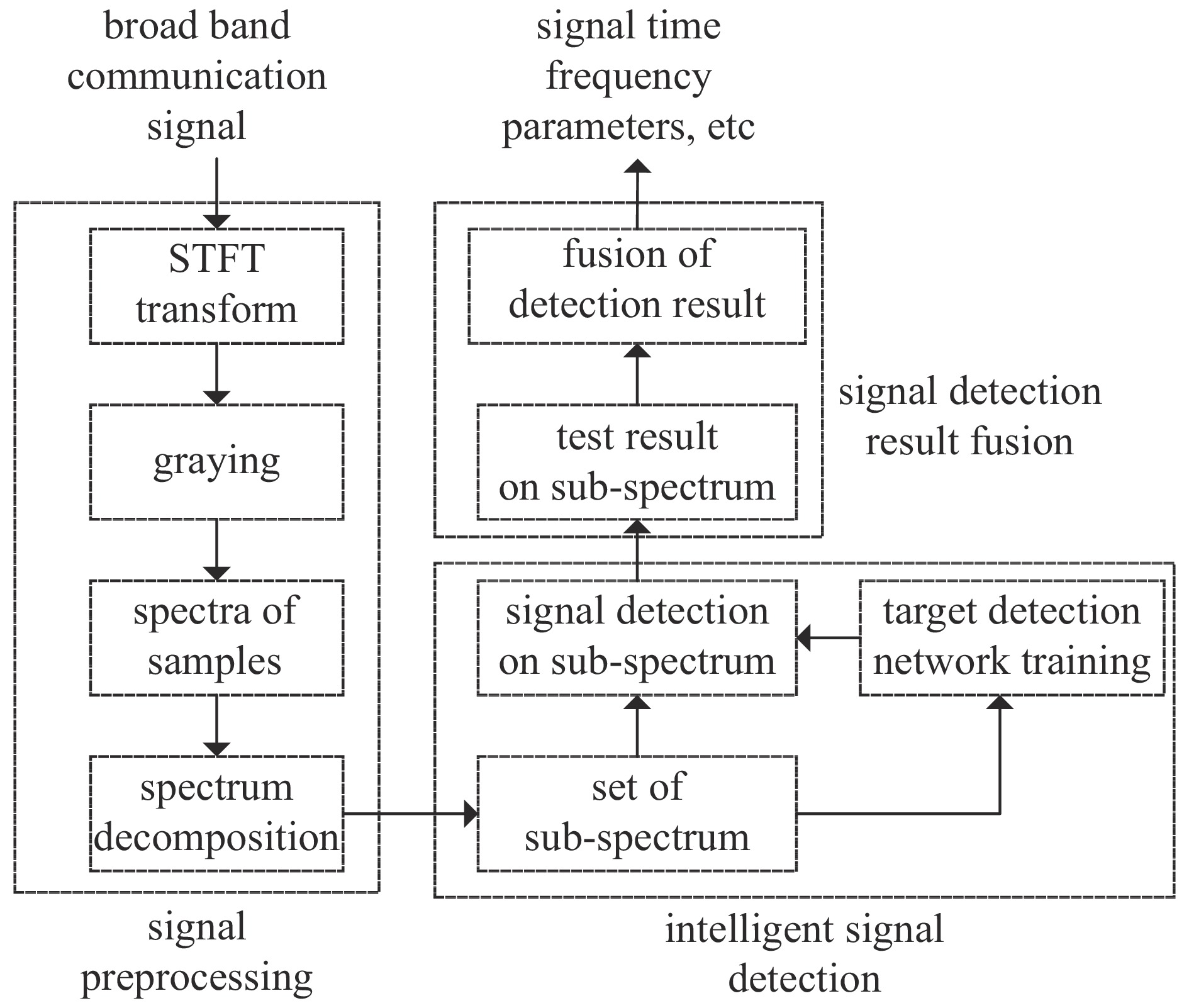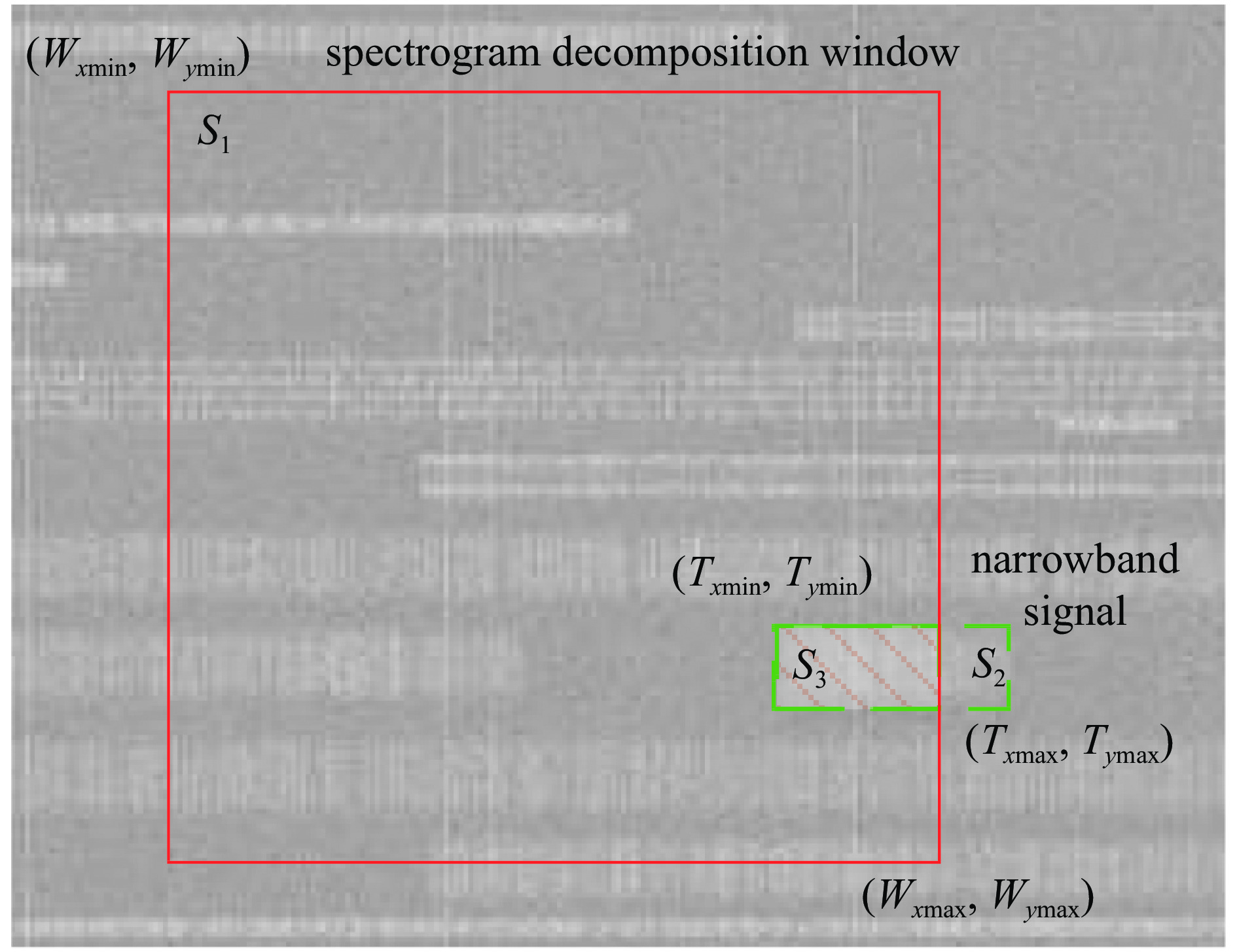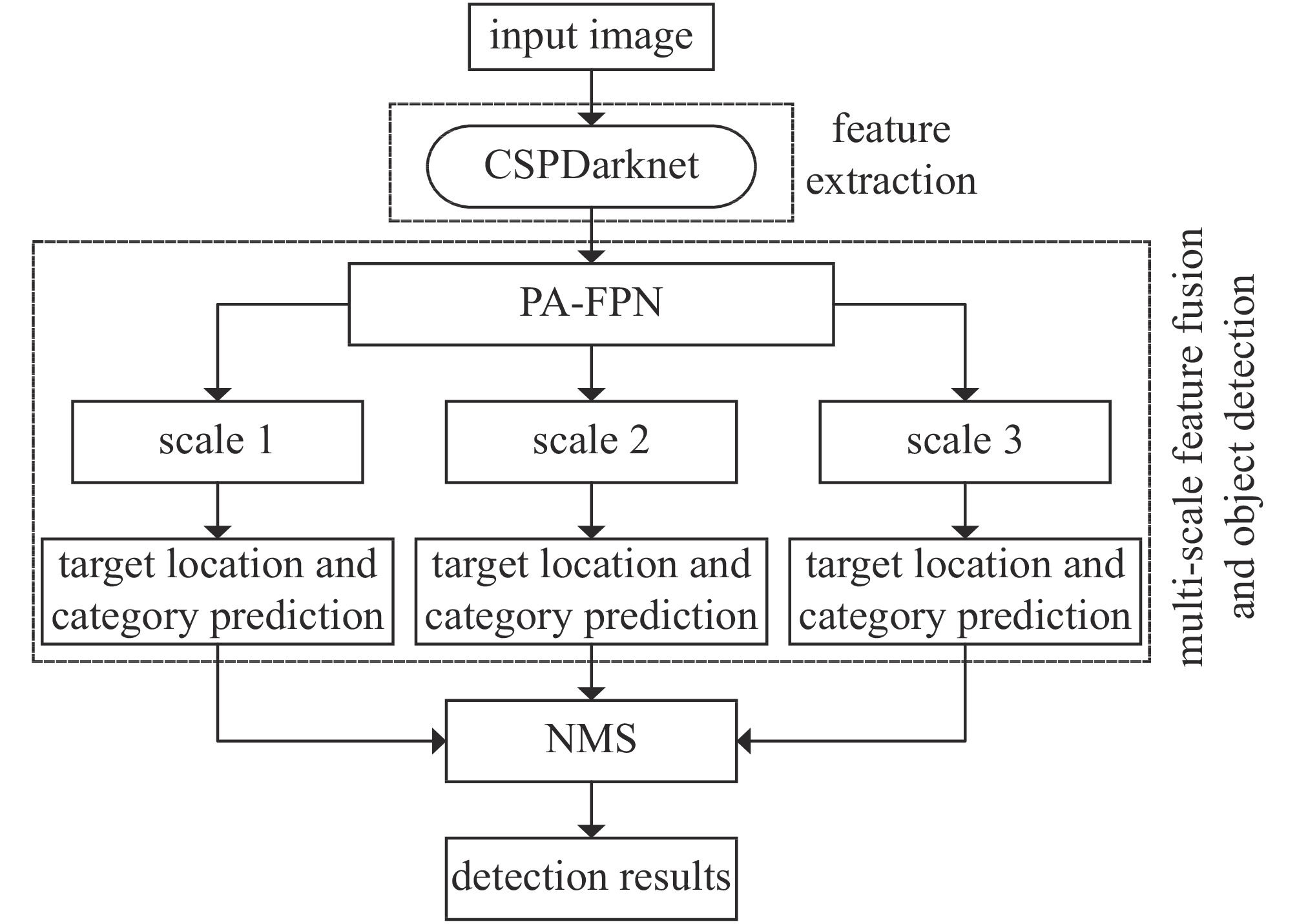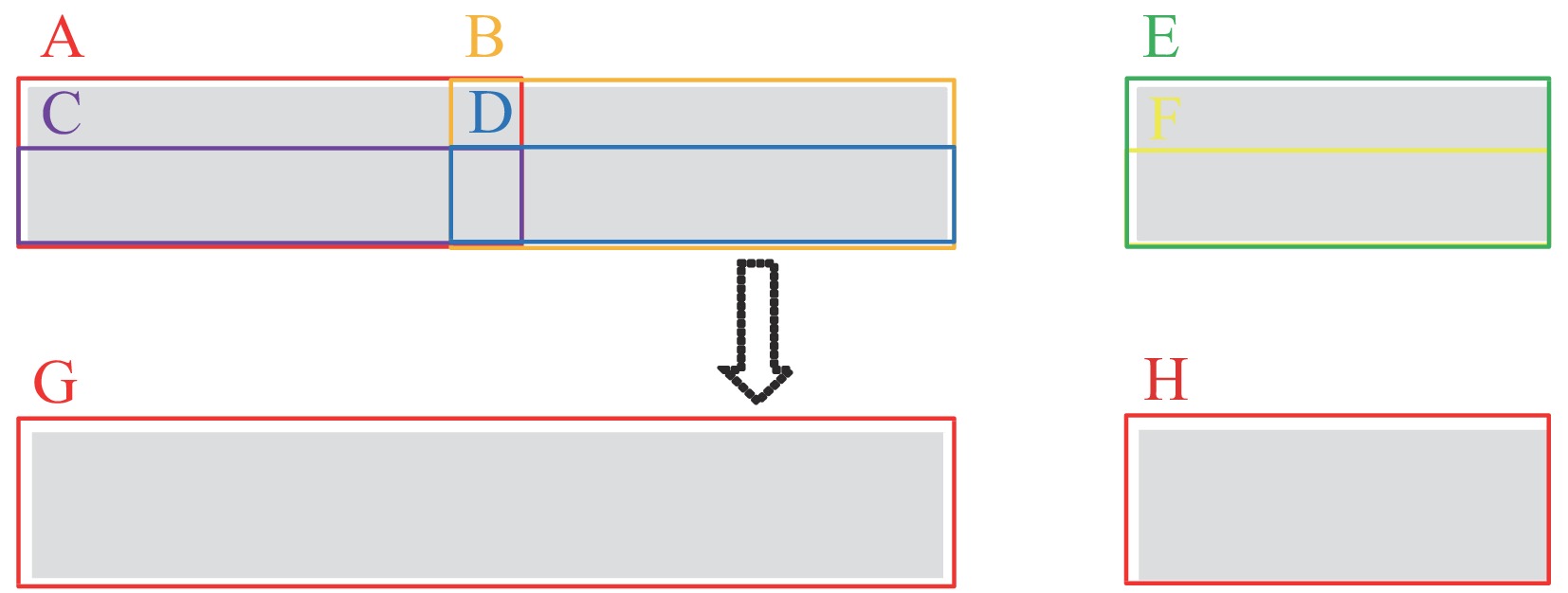Intelligent detection algorithm of broadband communication signal based on spectral decomposition
-
摘要: 对于宽带通信信号检测问题,针对目前基于深度学习的信号检测算法不适应于处理大带宽和大时宽的宽带信号以及对信号时频参数估计存在的固有偏差问题,提出基于谱图分解的宽带通信信号智能检测算法,完成对大带宽接收信号中窄带信号的高效准确检测。首先将由宽带信号转化而来的灰度时频谱图通过谱图分解得到适合于目标检测网络输入大小的子谱图,然后使用改进的无锚框YOLOx目标检测算法对子谱图中的窄带信号进行检测,最后将子谱图的信号检测结果融合得到窄带信号的时频参数等检测结果。经过实验测试得出,该算法能够适应复杂的噪声环境,与其他深度学习算法和传统算法相比,具有较高的信号检测概率,较低的虚警概率,较小的信号参数估计平均误差,其检测精度更高,鲁棒性、实用性、通用性更强。Abstract: For broadband communication signal detection problem, as the current signal detection algorithm based on deep learning is not suitable for dealing with large bandwidth and large wide broadband signals, and there is the inherent deviation in signal frequency parameter estimation, we put forward intelligent broadband communication signal detection algorithm based on spectrum decomposition, thus to complete highly accurate detection of narrow-band signal in large bandwidth receiving signal. First, the broadband signal is transformed into a grayscale time-frequency spectrum which is subsequently decomposed into a sub-spectrum suitable for the input size of the target detection network. Then, the anchor-free YOLOx target detection algorithm is used to detect the narrowband signal targets in the sub-spectrum. Finally, the signal detection results of the sub-spectrum are fused to obtain the detection results of the time-frequency parameters of the narrow-band signal. Experimental results show that the proposed algorithm can adapt to the complex noise environment. Compared with other deep learning algorithms and traditional energy detection algorithms, the proposed algorithm has higher signal detection accuracy, lower false alarm probability, smaller average error of signal parameter estimation, and stronger robustness, practicability and versatility.
-
表 1 仿真数据集主要参数
Table 1. Results of experiments
parameter values parameter values bandwidth range 0~3200 kHz signal types wideband real signal sampling frequency 6400 kHz time range 2000 ms time-frequency spectrum frequency resolution 1 kHz time-frequency spectrum time resolution 1 ms size of time-frequency spectrum 3200×3999 the number of narrowband signals in a wideband signal 40~70 target signal frequency range 5~3115 kHz target signal bandwidth range 5~100 kHz target signal modulation pattern 2FSK, 4FSK, 8FSK, MPSK whether there is a burst signal yes burst signal burst interval 10~1500 ms burst signal duration 10~1500 ms parameter values channel environment Rayleigh fading channel + non-stationary undulation noise + α-stabilized noise number of target signals in training set 800 time-frequency spectrums, a total of 40 854 signals, 75% for training, 25% for validation number of target signals in test set 0~20 dB stepped at 2 dB, and 100 time-frequency spectrums under each SNR, with a total of
61 373 signals表 2 检测网络对单子谱图的检测时间
Table 2. Detection time of monad spectra detected by the network
detection algorithm single sub-spectrum detection time/ms proposed algorithm 45.0 spectrogram decomposition combined with Ref. [16] 50.1 -
[1] Green D M, Swets J A. Signal detection theory and psychophysics[M]. New York: Wiley, 1966. [2] Abdzadeh-Ziabari H, Champagne B. Signal detection algorithms for single carrier generalized spatial modulation in doubly selective channels[J]. Signal Processing, 2020, 172: 107539. doi: 10.1016/j.sigpro.2020.107539 [3] 胡涛. 宽带侦察接收机前端研制[D]. 成都: 电子科技大学, 2018Hu Tao. Development of wideband reconnaissance receiver front end[D]. Chengdu: University of Electronic Science and Technology of China, 2018 [4] Joykutty A M, Baranidharan B. Cognitive Radio Networks: Recent advances in spectrum sensing techniques and security[C]//2020 International Conference on Smart Electronics and Communication (ICOSEC). 2020. [5] Cheng Qian, Gong Kexian, Zhang Min, et al. An efficient wide-band signal detection and extraction method[J]. MATEC Web of Conferences, 2021, 336: 04011. doi: 10.1051/matecconf/202133604011 [6] 魏东兴, 殷福亮. 采用离散小波变换的认知无线电频谱能量检测[J]. 信号处理, 2014, 30(3):306-313 doi: 10.3969/j.issn.1003-0530.2014.03.008Wei Dongxing, Yin Fuliang. Spectrum energy detection using discrete wavelet transform for cognitive radios[J]. Journal of Signal Processing, 2014, 30(3): 306-313 doi: 10.3969/j.issn.1003-0530.2014.03.008 [7] 李敏乐, 毕大平, 韩佳辉. 基于形态学运算的子带频谱检测算法[J]. 探测与控制学报, 2017, 39(4):49-53,60Li Minle, Bi Daping, Han Jiahui. Sub-band spectrum detection algorithm based on morphological operation in complicated noise environment[J]. Journal of Detection & Control, 2017, 39(4): 49-53,60 [8] 蒋天立, 彭华, 巩克现. 多尺度形态学滤波下的宽带信号检测方法[J]. 信号处理, 2014, 30(9):1055-1063 doi: 10.3969/j.issn.1003-0530.2014.09.009Jiang Tianli, Peng Hua, Gong Kexian. Signal detection in wideband reconnaissance using multi-scale morphological filter[J]. Journal of Signal Processing, 2014, 30(9): 1055-1063 doi: 10.3969/j.issn.1003-0530.2014.09.009 [9] Du Xuedan, Cai Yinghao, Wang Shuo, et al. Overview of deep learning[C]//2016 31st Youth Academic Annual Conference of Chinese Association of Automation (YAC). 2016. [10] Mathew A, Amudha P, Sivakumari S. Deep learning techniques: an overview[C]//International Conference on Advanced Machine Learning Technologies and Applications. Singapore: Springer, 2020. [11] Dörner S, Cammerer S, Hoydis J, et al. Deep learning based communication over the air[J]. IEEE Journal of Selected Topics in Signal Processing, 2018, 12(1): 132-143. doi: 10.1109/JSTSP.2017.2784180 [12] O’Shea T J, Roy T, Clancy T C. Over-the-air deep learning based radio signal classification[J]. IEEE Journal of Selected Topics in Signal Processing, 2018, 12(1): 168-179. doi: 10.1109/JSTSP.2018.2797022 [13] O'Shea T, Roy T, Clancy T C. Learning robust general radio signal detection using computer vision methods[C]//2017 51st Asilomar Conference on Signals, Systems, and Computers. 2017: 829-832. [14] Zha Xiong, Peng Hua, Qin Xin, et al. A deep learning framework for signal detection and modulation classification[J]. Sensors, 2019, 19(18): 4042. doi: 10.3390/s19184042 [15] 查雄. 基于神经网络的数字调制信号检测, 识别与解调算法[D]. 郑州: 战略支援部队信息工程大学, 2020Zha Xiong. Research on digital modulation signal detection, recognition and demodulation based on neural network [D]. Zhengzhou: Information Engineering University, 2020 [16] Li Rundong, Hu Jianhao, Li Shaoqian, et al. Blind detection of communication signals based on improved YOLO3[C]//2021 6th International Conference on Intelligent Computing and Signal Processing (ICSP). 2021: 424-429. [17] Ge Zheng, Liu Songtao, Wang Feng, et al. YOLOX: Exceeding YOLO series in 2021[DB/OL]. arXiv preprint arXiv: 2107.08430, 2021. [18] Shepley A, Falzon G, Kwan P. Confluence: A robust non-IoU alternative to non-maxima suppression in object detection[DB/OL]. arXiv preprint arXiv: 2012.00257, 2020. [19] Yu Jiahui, Jiang Yuning, Wang Zhangyang, et al. UnitBox: An advanced object detection network[C]//Proceedings of the 24th ACM International Conference on Multimedia. 2016. [20] Zheng Zhaohui, Wang Ping, Liu Wei, et al. Distance-IoU loss: Faster and better learning for bounding box regression[C]//Proceedings of the Thirty-Fourth AAAI Conference on Artificial Intelligence. Palo Alto: AAAI Press, 2020. -




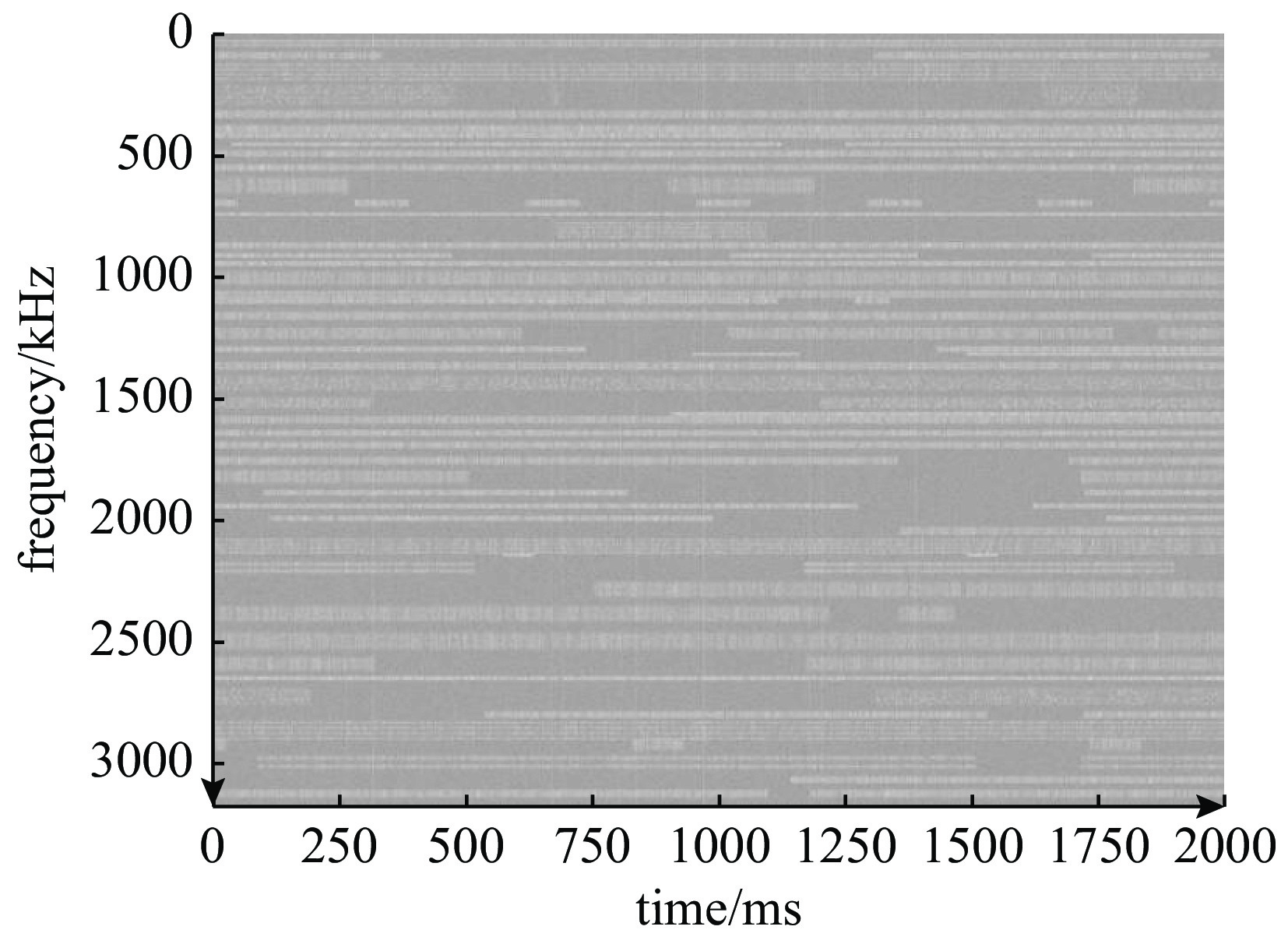
 下载:
下载:
